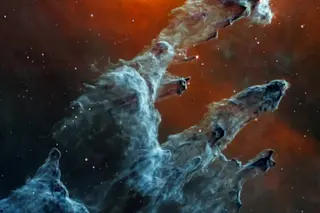NASA’s James Webb Space Telescope (JWST) carried out yet another magic trick when it released its latest image of the Pillars of Creation, which makes thousands of stars seemingly vanish.
This stellar disappearing act was made possible thanks to JWST’s Mid-Infrared Instrument (MIRI), which is particularly sensitive to the many layers of gas and dust that call the Pillars of Creation home.
Although you can’t see many stars in this unique view of the Pillars, they are there. It’s just that stars typically don’t emit much light at mid-infrared wavelengths, instead primarily glowing in ultraviolet, visible, and near-infrared. For instance, JWST also captured another recent shot of the Pillars of Creation using its Near-Infrared Camera (NIRCam), which reveals myriad red stars forming within the Pillars.
Mid-infrared light may not reveal many stars, but it is fantastic at unmasking dense regions of gas and dust. The red regions toward the top ...














